A Bridged-Switch Energy-Efficient Switching Scheme for Successive Approximation Register Analog-to-Digital Converters with a Low-Complexity Capacitor Drive Circuit
Abstract
1. Introduction
2. The Proposed SAR ADC
2.1. The Proposed Switching Scheme
2.2. Drive Circuit for DAC Capacitor Array
2.3. Bridged Switch for DAC Capacitor Array
2.4. Sampling Switch
2.5. Comparator
2.6. SAR Logic
3. Results
4. Conclusions
Author Contributions
Funding
Institutional Review Board Statement
Informed Consent Statement
Data Availability Statement
Conflicts of Interest
Nomenclature
References
- Chung, Y.-H.; Zeng, Q.-F. A 12-Bit 100-kS/s SAR ADC for IoT Applications. In Proceedings of the 2020 International Symposium on VLSI Design, Automation and Test (VLSI-DAT), Hsinchu, Taiwan, 10–13 August 2020; pp. 1–4. [Google Scholar]
- Zhao, X.; Li, D.; Zhang, X.; Liu, S.; Zhu, Z. A 0.6-V 94-nW 10-Bit 200-kS/s Single-Ended SAR ADC for Implantable Biosensor Applications. IEEE Sens. J. 2022, 22, 17904–17913. [Google Scholar] [CrossRef]
- Hu, Y.; Hu, L.; Tang, B.; Li, B.; Wu, Z.; Liu, X. A 100 KS/s 8–10-Bit Resolution-Reconfigurable SAR ADC for Biosensor Applications. Micromachines 2022, 13, 1909. [Google Scholar] [CrossRef] [PubMed]
- Begum, F.; Mishra, S.; Islam, M.N.; Dandapat, A. A 10-Bit 2.33 fJ/Conv. SAR-ADC with High Speed Capacitive DAC Switching Using a Novel Effective Asynchronous Control Circuitry. Analog. Integr. Circ. Signal Process 2019, 100, 311–325. [Google Scholar] [CrossRef]
- Jian, M.; Zheng, J.; Kong, X.; Yuan, M.; Zhang, C.; Guo, C.; Sun, B. A 12-Bit SAR ADC with a Reversible VCM-Based Capacitor Switching Scheme. Microelectron. J. 2022, 129, 105588. [Google Scholar] [CrossRef]
- Tong, X.; Zhao, S.; Xin, X. High Energy Efficiency and Linearity Switching Scheme without Reset Energy for SAR ADC. Circuits Syst. Signal Process 2022, 41, 5872–5894. [Google Scholar] [CrossRef]
- Ginsburg, B.P.; Chandrakasan, A.P. An Energy-Efficient Charge Recycling Approach for a SAR Converter with Capacitive DAC. In Proceedings of the 2005 IEEE International Symposium on Circuits and Systems, Kobe, Japan, 23–26 May 2005; pp. 184–187. [Google Scholar]
- Liu, C.-C.; Chang, S.-J.; Huang, G.-Y.; Lin, Y.-Z. A 10-Bit 50-MS/s SAR ADC With a Monotonic Capacitor Switching Procedure. IEEE J. Solid State Circuits 2010, 45, 731–740. [Google Scholar] [CrossRef]
- Wang, H.; Zhu, Z. Energy-Efficient and Reference-Free Monotonic Capacitor Switching Scheme with Fewest Switches for SAR ADC. IEICE Electron. Express 2015, 12, 20141202. [Google Scholar] [CrossRef][Green Version]
- Huang, L.; Li, J.; Jiang, X.; Wu, J. A 2.1-fJ/Conversion-Step 10-Bit 125-KS/s SAR ADC with Vcm-Based Bidirectional Single-Side Switching Scheme. In Proceedings of the 2023 12th International Conference on Modern Circuits and Systems Technologies (MOCAST), Athens, Greece, 28–30 June 2023; pp. 1–4. [Google Scholar]
- Hsieh, S.-E.; Hsieh, C.-C. A 0.3-V 0.705-fJ/Conversion-Step 10-Bit SAR ADC With a Shifted Monotonic Switching Procedure in 90-Nm CMOS. IEEE Trans. Circuits Syst. II Express Briefs 2016, 63, 1171–1175. [Google Scholar] [CrossRef]
- Yuan, C.; Lam, Y. Low-Energy and Area-Efficient Tri-Level Switching Scheme for SAR ADC. Electron. Lett. 2012, 48, 482–483. [Google Scholar] [CrossRef]
- Zhu, Z.; Xiao, Y.; Song, X. VCM-Based Monotonic Capacitor Switching Scheme for SAR ADC. Electron. Lett. 2013, 49, 327–329. [Google Scholar] [CrossRef]
- Hu, Y.; Liu, A.; Li, B.; Wu, Z. Closed-loop Charge Recycling Switching Scheme for SAR ADC. Electron. Lett. 2017, 53, 66–68. [Google Scholar] [CrossRef]
- Abo, A.M.; Gray, P.R. A 1.5-V, 10-Bit, 14.3-MS/s CMOS Pipeline Analog-to-Digital Converter. IEEE J. Solid State Circuits 1999, 34, 599–606. [Google Scholar] [CrossRef]
- Yuan, F. Bootstrapping Techniques for Energy-Efficient Successive Approximation ADC. Analog. Integr. Circ. Signal Process 2023, 114, 299–313. [Google Scholar] [CrossRef]
- Schinkel, D.; Mensink, E.; Klumperink, E.; Van Tuijl, E.; Nauta, B. A Double-Tail Latch-Type Voltage Sense Amplifier with 18ps Setup+Hold Time. In Proceedings of the 2007 IEEE International Solid-State Circuits Conference, Digest of Technical Papers, San Francisco, CA, USA, 11–15 February 2007; pp. 314–605. [Google Scholar]
- Savani, V.; Devashrayee, N.M. Analysis and Design of Low-Voltage Low-Power High-Speed Double Tail Current Dynamic Latch Comparator. Analog. Integr. Circ. Signal Process 2017, 93, 287–298. [Google Scholar] [CrossRef]
- Babayan-Mashhadi, S.; Lotfi, R. Analysis and Design of a Low-Voltage Low-Power Double-Tail Comparator. IEEE Trans. VLSI Syst. 2014, 22, 343–352. [Google Scholar] [CrossRef]
- Harpe, P.J.A.; Zhou, C.; Bi, Y.; Van Der Meijs, N.P.; Wang, X.; Philips, K.; Dolmans, G.; De Groot, H. A 26 μW 8 Bit 10 MS/s Asynchronous SAR ADC for Low Energy Radios. IEEE J. Solid State Circuits 2011, 46, 1585–1595. [Google Scholar] [CrossRef]
- Zhu, Z.; Xiao, Y.; Wang, W.; Wang, Q.; Yang, Y. A 0.6 V 100 KS/s 8–10 b Resolution Configurable SAR ADC in 0.18 Μm CMOS. Analog. Integr. Circ. Signal Process 2013, 75, 335–342. [Google Scholar] [CrossRef]
- Zhu, Z.; Xiao, Y.; Liang, L.; Liu, L.; Yang, Y. A 3.03 μW 10-BIT 200 KS/s SAR ADC IN 0.18 μM CMOS. J. Circuit. Syst. Comp. 2013, 22, 1350026. [Google Scholar] [CrossRef]
- Zhu, Z.; Qiu, Z.; Liu, M.; Ding, R. A 6-to-10-Bit 0.5 V-to-0.9 V Reconfigurable 2 MS/s Power Scalable SAR ADC in 0.18 μM CMOS. IEEE Trans. Circuits Syst. I Regul. Pap. 2015, 62, 689–696. [Google Scholar] [CrossRef]
- He, X.; He, J.; Cai, M.; Jing, Z. A Low Power Switching Method with Variable Comparator Reference Voltage and Split Capacitor Array for SAR ADC. In Proceedings of the 2016 IEEE International Conference on Electron Devices and Solid-State Circuits (EDSSC), Hong Kong, China, 3–5 August 2016; pp. 379–382. [Google Scholar]
- Rasool Ghasemi, A.; Saberi, M.; Lotfi, R. A Low-Power Capacitor Switching Scheme with Low Common-Mode Voltage Variation for Successive Approximation ADC. Microelectron. J. 2017, 61, 15–20. [Google Scholar] [CrossRef]
- Zha, Y.; Zahnd, L.; Deng, J.; Ruffieux, D.; Badami, K.; Mavrogordatos, T.; Matsuo, Y.; Emery, S. An Untrimmed PVT-Robust 12-Bit 1-MS/s SAR ADC IP in 55nm Deeply Depleted Channel CMOS Process. In Proceedings of the 2019 IEEE Asian Solid-State Circuits Conference (A-SSCC), Macau, China, 4–6 November 2019; pp. 13–16. [Google Scholar]
- Sotoudeh, M.; Rezaei, F. A Four-Level Switching Scheme for SAR ADCs with 87.5% Area Saving and 97.85% Energy-Reduction. Circuits Syst. Signal Process 2020, 39, 4792–4809. [Google Scholar] [CrossRef]

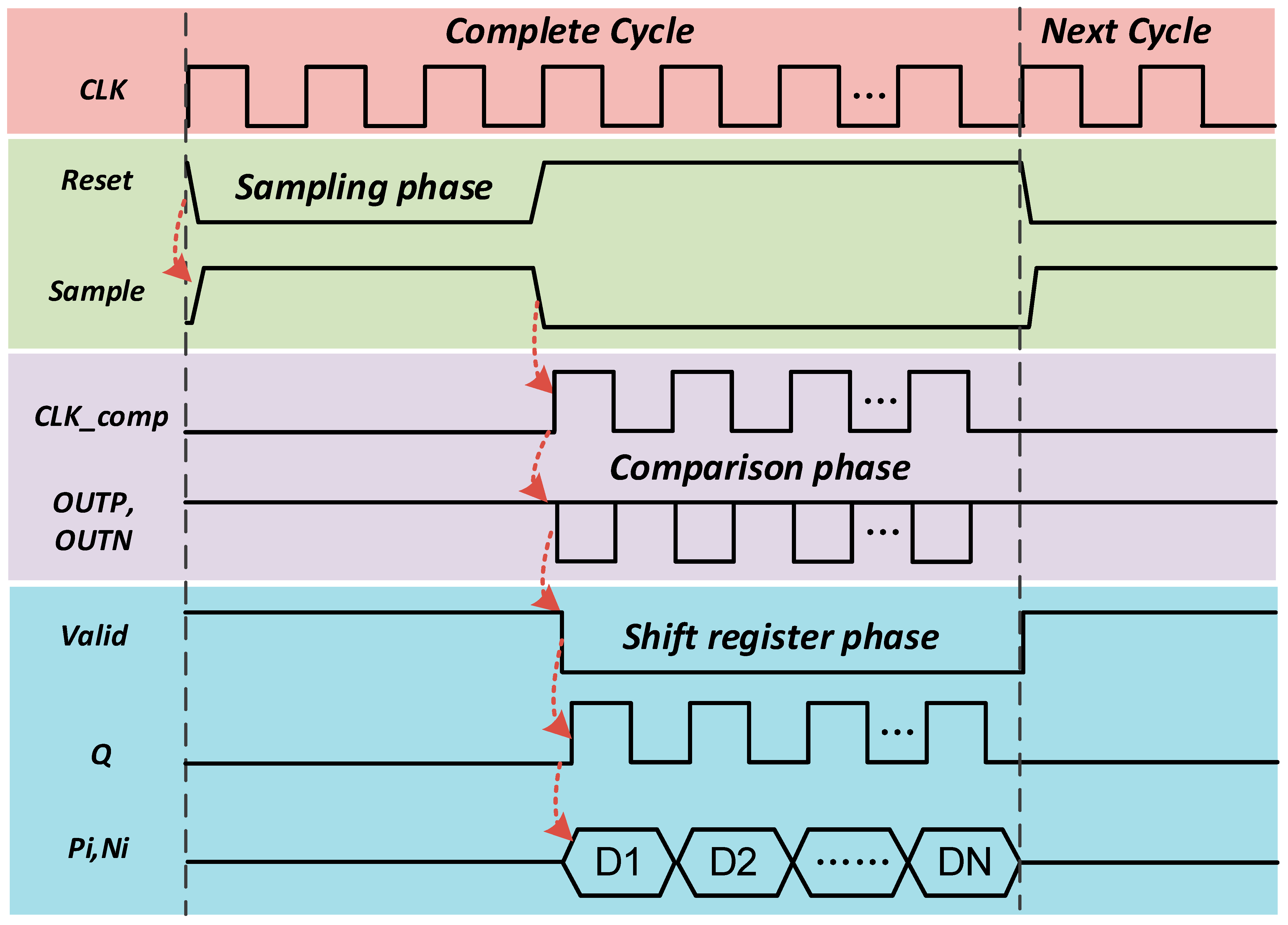
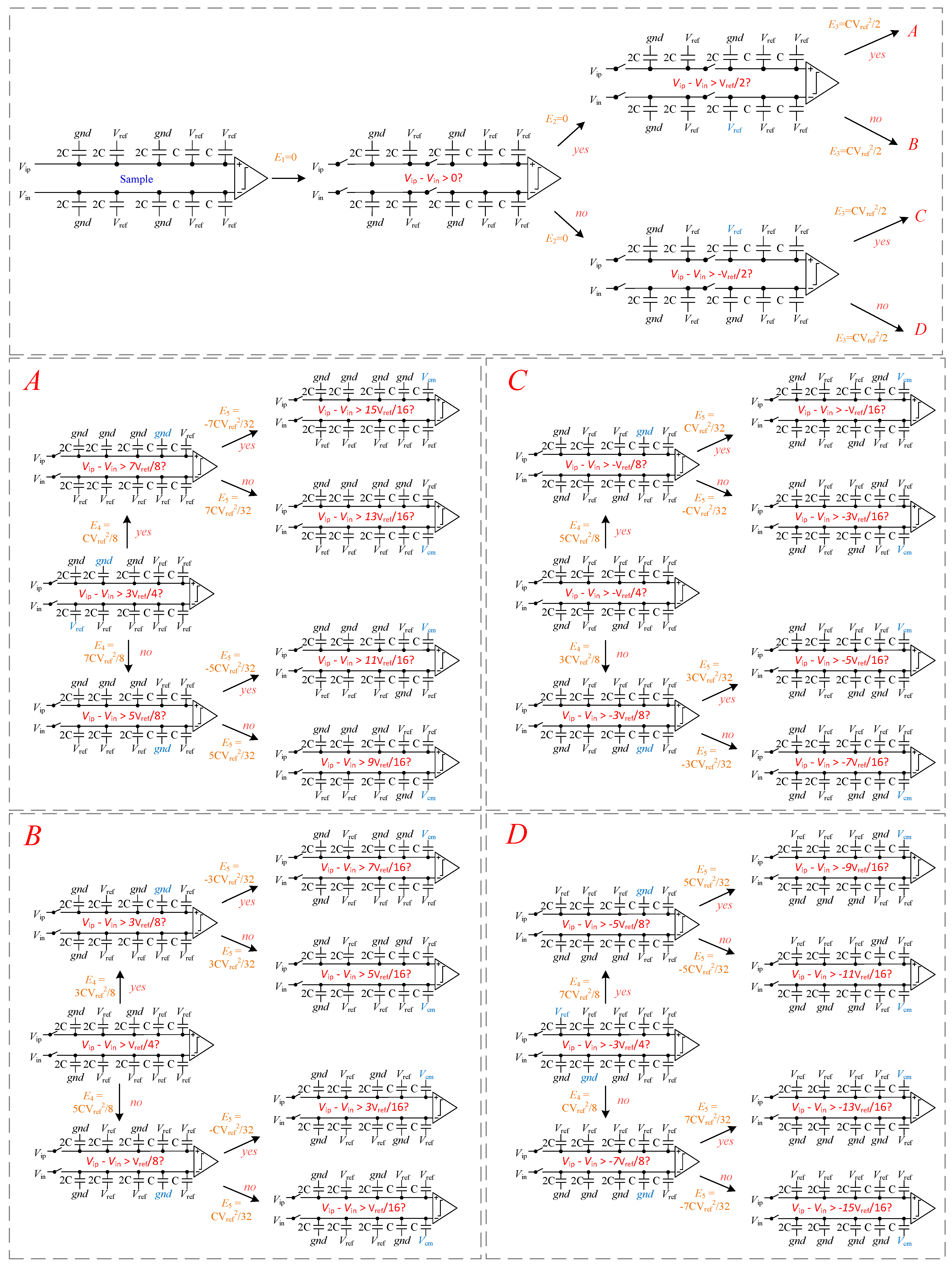

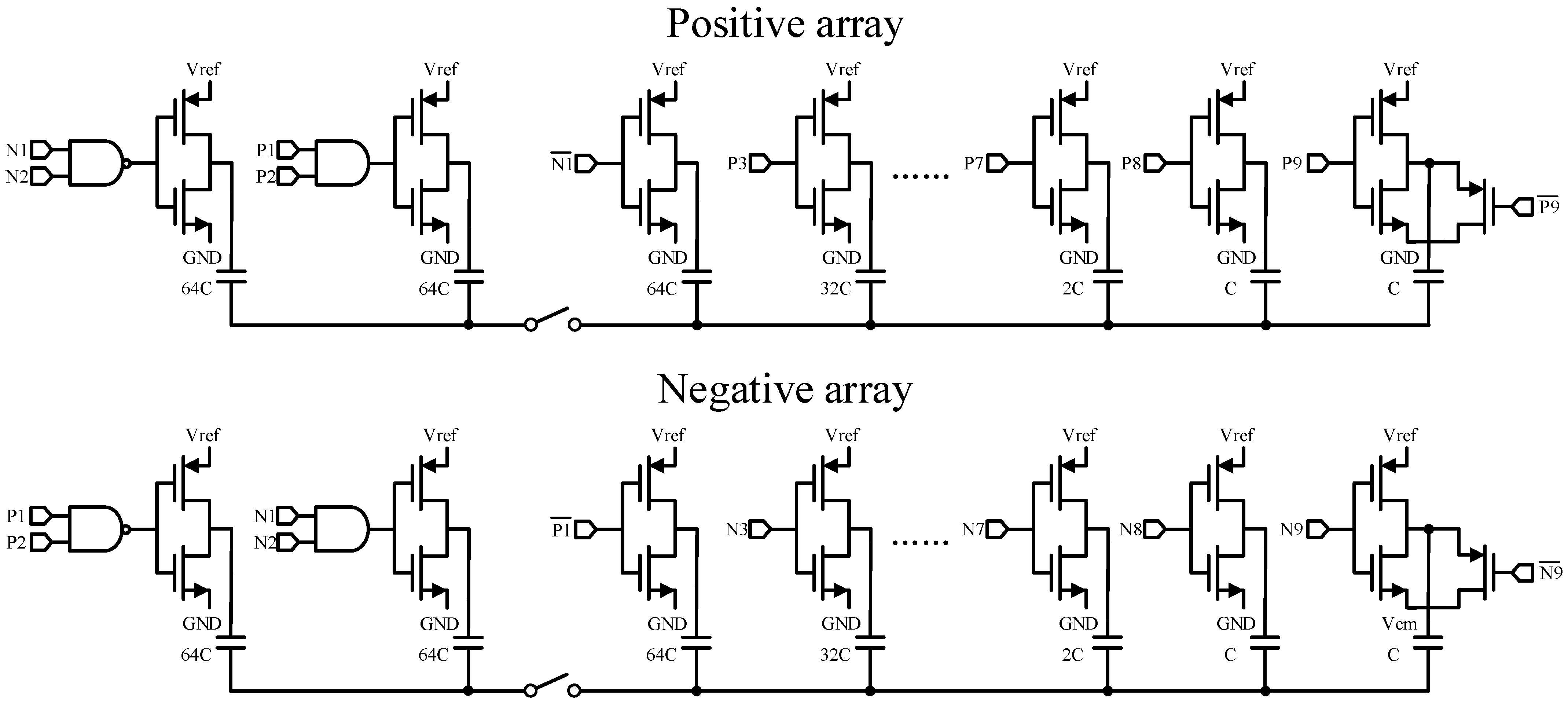

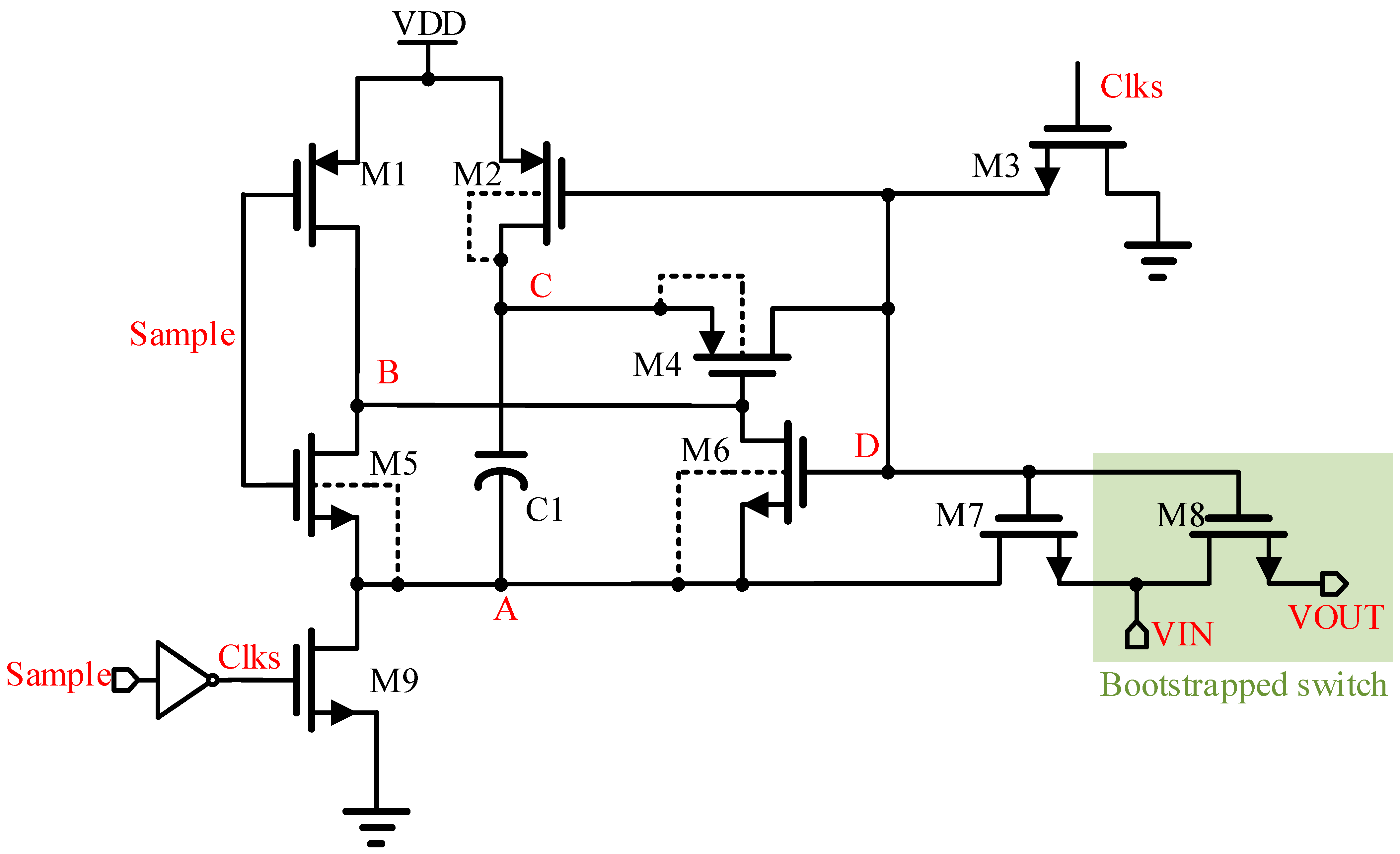
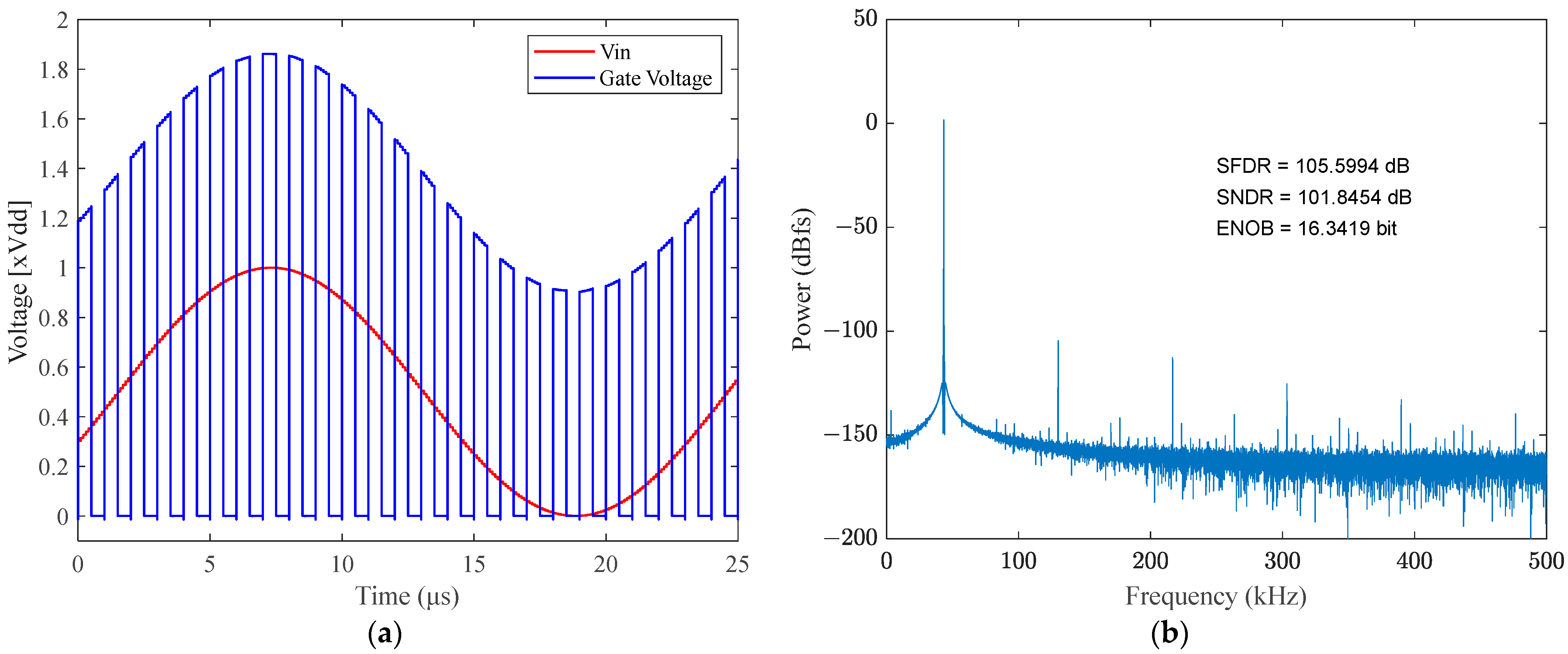
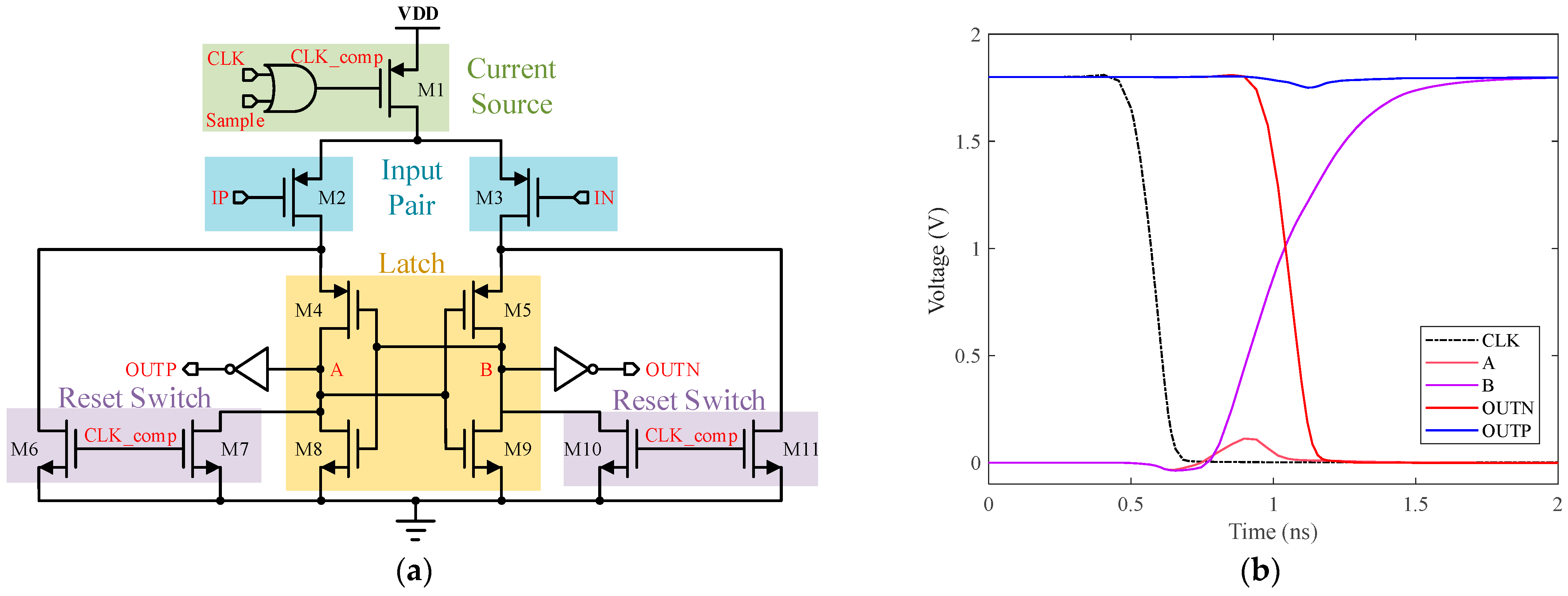
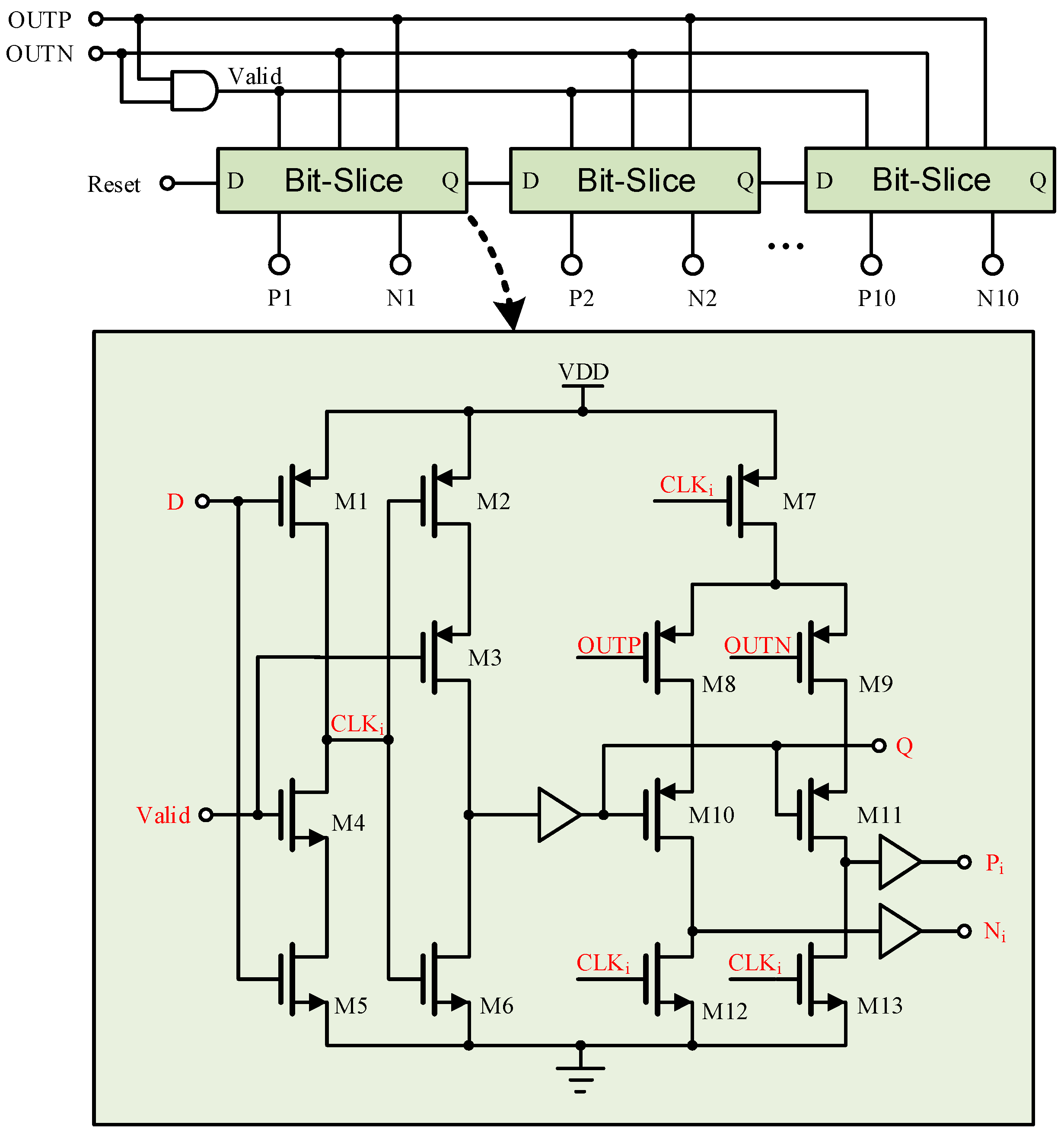


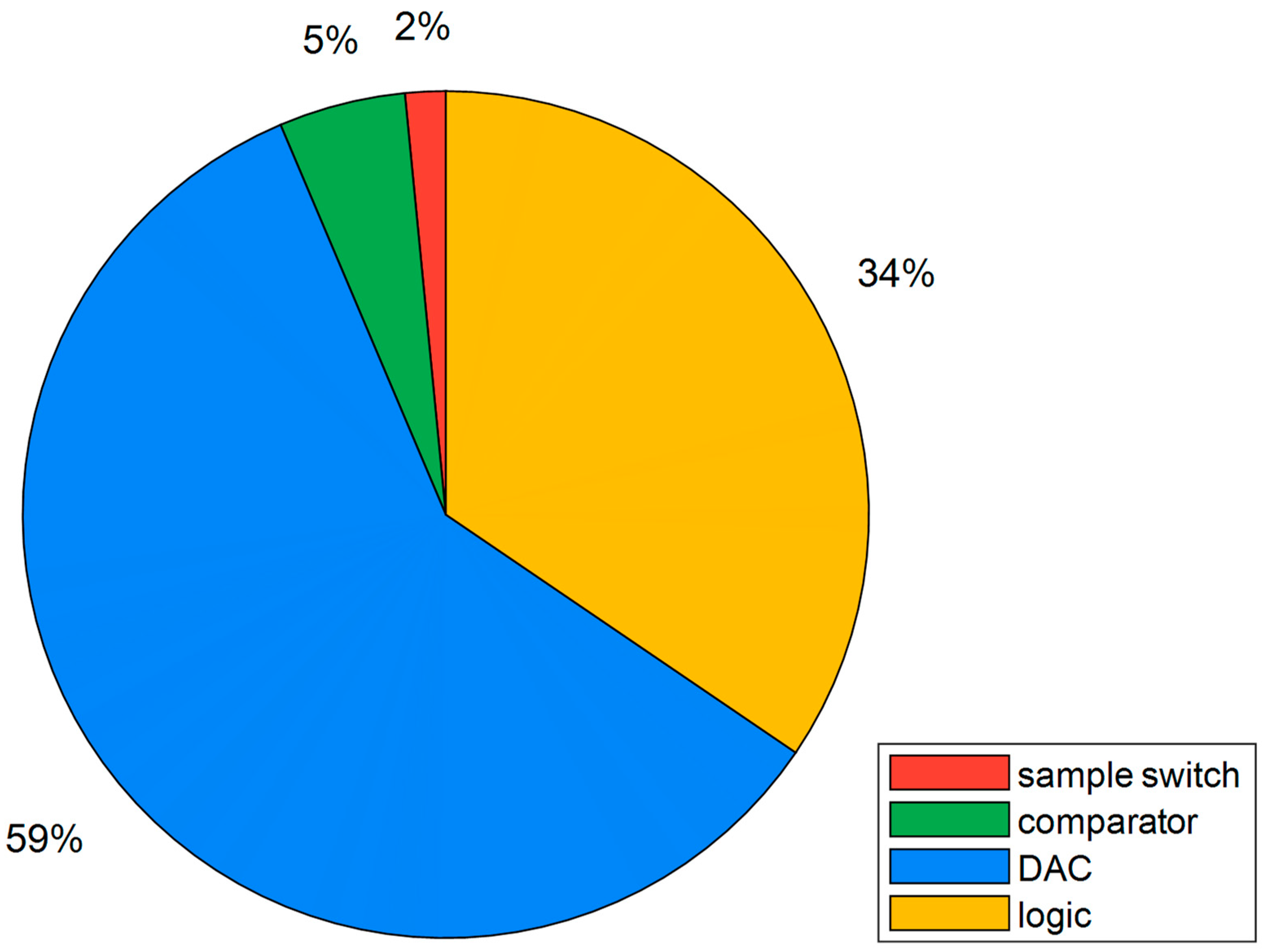
| Switching Scheme | Average Switching Energy (CV2ref) | Energy Saving | Area Reduction | Control Logic Complexity | Dependency on the Accuracy of Vcm | Common-Mode Shift |
|---|---|---|---|---|---|---|
| Conventional | 1363.3 | Reference | Reference | Low | No | 0 |
| SC [7] | 852.3 | 37.48% | 0% | Low | No | 0 |
| MCS [8] | 255.5 | 81.26% | 50% | Low | No | Vref/2 |
| RFM [9] | 128 | 90.61% | 74.7% | Low | No | Vref/2 |
| VBSS [10] | 69.08 | 94.93% | 75% | Low | Very high | Vref/4 |
| SMS [11] | 63.75 | 95.32% | 75% | Low | Very high | Vref/4 |
| Tri-level [12] | 42.41 | 96.89% | 75% | High | Very high (all bits except MSB) | Vref/2 |
| VMS [13] | 31.88 | 97.66% | 75% | High | Very high (all bits except MSB) | Vref/4 |
| Proposed | 47.5 | 96.52% | 75% | Low | Very low (only LSB) | Vref/4 |
| Parameter | [24] * | [25] * | [26] | [27] * | [6] * | This Work * |
|---|---|---|---|---|---|---|
| Year | 2016 | 2017 | 2019 | 2020 | 2022 | 2023 |
| Process (nm) | 180 | 180 | 55 | 130 | 180 | 180 |
| Resolution (bits) | 8 | 10 | 12 | 8 | 10 | 10 |
| Sampling rate (MS/s) | 1 | 1 | 1 | 1 | 1 | 1 |
| Supply voltage (V) | 1.2 | 1.8 | 0.5/0.9 | 1.2 | 1 | 1.8 |
| SNDR (dB) | 48.05 | 61 | 68 | 47.12 | 57.81 | 60.76 |
| SFDR (dB) | - | 79.8 | - | 57.36 | 68.63 | 69.85 |
| ENOB (bits) | 7.69 | 9.84 | - | 7.54 | 9.31 | 9.8 |
| DNL (LSB) | −0.14/0.68 | - | −0.58/0.60 | −0.24 /0.26 | - | −0.16/0.14 |
| INL (LSB) | −0.31/0.48 | - | −0.81/0.58 | −0.28/0.26 | - | −0.25/0.11 |
| Power consumption (μW) | 8.14 | 35.3 | 30 | 11. 56 | 15.25 | 14.7 |
| FoM 1 (fJ/conv.-step) | 39 | 38.52 | 24.5 | 62.11 | 20 | 16.55 |
Disclaimer/Publisher’s Note: The statements, opinions and data contained in all publications are solely those of the individual author(s) and contributor(s) and not of MDPI and/or the editor(s). MDPI and/or the editor(s) disclaim responsibility for any injury to people or property resulting from any ideas, methods, instructions or products referred to in the content. |
© 2023 by the authors. Licensee MDPI, Basel, Switzerland. This article is an open access article distributed under the terms and conditions of the Creative Commons Attribution (CC BY) license (https://creativecommons.org/licenses/by/4.0/).
Share and Cite
Hu, Y.; Tang, B.; Chen, C.; Hu, L.; Huang, Q.; Cai, J.; Xie, J.; Li, B.; Wu, Z. A Bridged-Switch Energy-Efficient Switching Scheme for Successive Approximation Register Analog-to-Digital Converters with a Low-Complexity Capacitor Drive Circuit. Appl. Sci. 2023, 13, 12897. https://doi.org/10.3390/app132312897
Hu Y, Tang B, Chen C, Hu L, Huang Q, Cai J, Xie J, Li B, Wu Z. A Bridged-Switch Energy-Efficient Switching Scheme for Successive Approximation Register Analog-to-Digital Converters with a Low-Complexity Capacitor Drive Circuit. Applied Sciences. 2023; 13(23):12897. https://doi.org/10.3390/app132312897
Chicago/Turabian StyleHu, Yunfeng, Bin Tang, Chaoyi Chen, Lexing Hu, Qingming Huang, Jiaqi Cai, Jinbo Xie, Bin Li, and Zhaohui Wu. 2023. "A Bridged-Switch Energy-Efficient Switching Scheme for Successive Approximation Register Analog-to-Digital Converters with a Low-Complexity Capacitor Drive Circuit" Applied Sciences 13, no. 23: 12897. https://doi.org/10.3390/app132312897
APA StyleHu, Y., Tang, B., Chen, C., Hu, L., Huang, Q., Cai, J., Xie, J., Li, B., & Wu, Z. (2023). A Bridged-Switch Energy-Efficient Switching Scheme for Successive Approximation Register Analog-to-Digital Converters with a Low-Complexity Capacitor Drive Circuit. Applied Sciences, 13(23), 12897. https://doi.org/10.3390/app132312897






